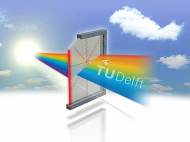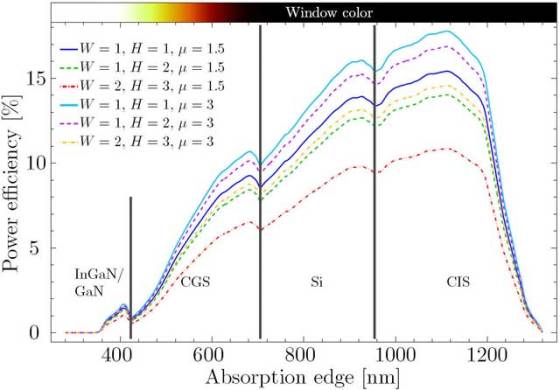Luminescent solar concentrators – power generating windows
 There are various attempts to transform windows and glazed facades into means able to generate electricity, thus providing a potentially cheap and easy to implement power-generating opportunity. Researchers from Delft University of Technology (TU Delft) are developing luminescent solar concentrators – a type of windows fitted with a thin film of material that absorbs sunlight and directs it to narrow solar cells at the perimeter of the window.
There are various attempts to transform windows and glazed facades into means able to generate electricity, thus providing a potentially cheap and easy to implement power-generating opportunity. Researchers from Delft University of Technology (TU Delft) are developing luminescent solar concentrators – a type of windows fitted with a thin film of material that absorbs sunlight and directs it to narrow solar cells at the perimeter of the window.
TU Delft graduating student Jan Willem Wiegman, and his supervisor at TU Delft, Erik van der Kolk, recently published their results how much electricity can be generated using so-called luminescent solar concentrators. The study shows the relationship between the color of the material used and the maximum amount of power that can be generated.
A thin layer of a luminescent material such as a foil or a coating is applied to windows to absorb sunlight and guide it to the solar cells at the perimeter, where it is converted into electricity. This enables a large surface area of sunlight to be concentrated on a narrow strip of solar cells, thus allowing this type of windows to generate dozens of watts per square meter of window surface.
According to results published by researchers, the exact amount of power produced by the windows depends on the color and quality of the light-emitting layer and the performance of the solar cells. A transparent film produces a maximum of 20 watts per square meter, which is an efficiency of 2%. While this is far from results other solar harvesting technologies are able to achieve, bear in mind the transparency and density this approach uses.
By using a foil that absorbs light particles from a certain part of the solar spectrum, the efficiency increases since the film is able to absorb more light particles. The foil can absorbs all the colors of the solar spectrum equally, thus providing efficiency of 9% – a figure comparable to the efficiency of flexible solar cells.
By absorbing all the colors of the light spectrum, the foil would give the window a grey tint, but the same technology could be used to absorb different parts of the spectrum. For instance, a foil that mainly absorbs the blue, violet and green light particles will give the window a red color and it has shown the same efficiency as the foil which absorbs all the colors of the spectrum equally.
The research has also shown the importance of a smooth film surface for the efficient transport of light particles to the perimeter of the window, since it lowers the scattering of energy between the film and the window surface.
For more information, read the paper published in the journal Solar Energy Materials and Solar Cells: “Building integrated thin film luminescent solar concentrators: Detailed efficiency characterization and light transport modelling”.










Leave your response!